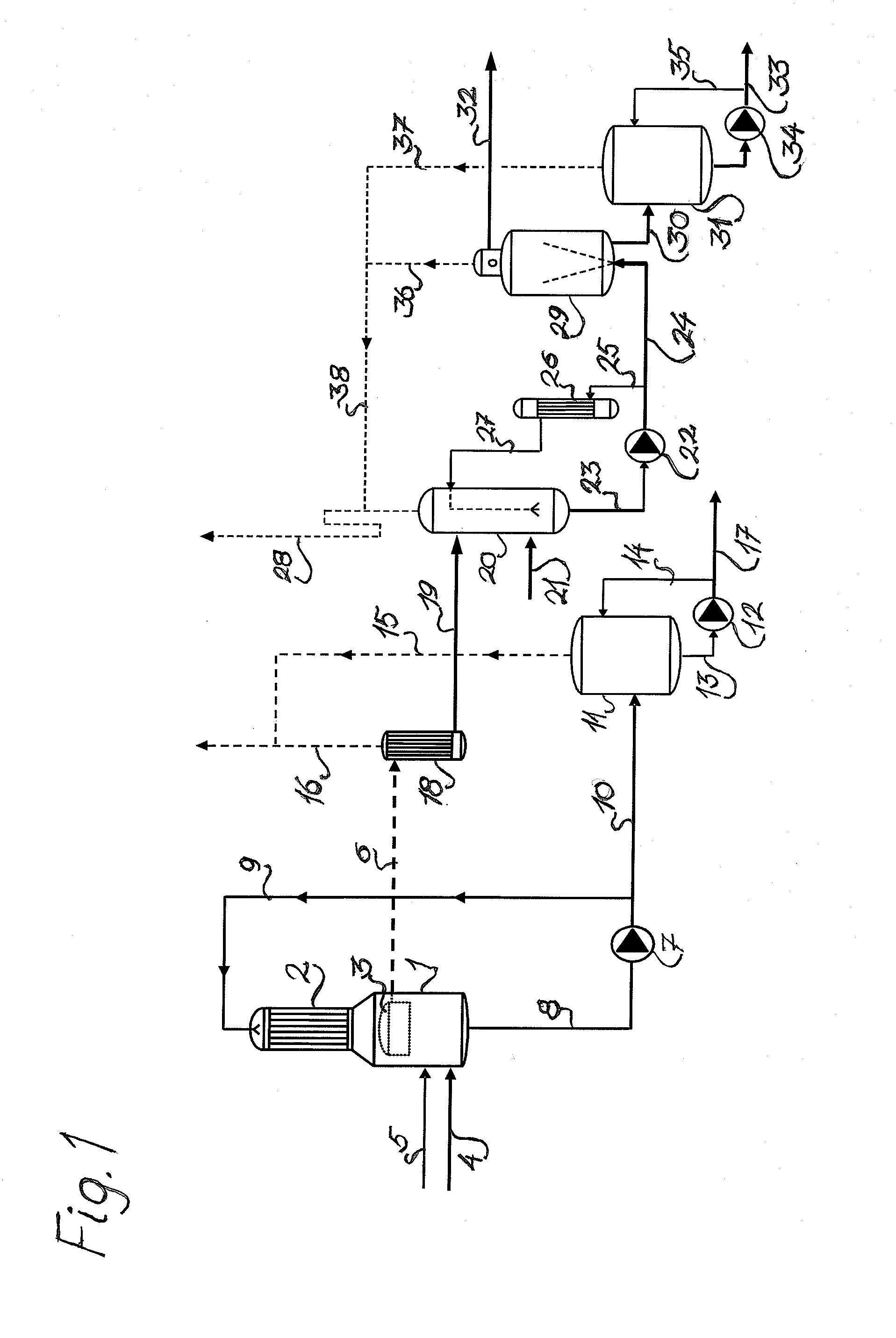Method for extracting ammonium salt and methanol from a liquid obtained from foul condensates in a cellulose pulp mill
a technology of cellulose pulp mill and ammonium salt, which is applied in the direction of ammonium sulfates, ammonium nitrates, inorganic chemistry, etc., can solve the problems of inability to sell purified nitrogen-rich condensate on the open market, the method that is disclosed also has weaknesses and shortcomings, and the use of a large amount of acid, so as to prevent the emission of nox and increase the number of uses of highly purified methanol
- Summary
- Abstract
- Description
- Claims
- Application Information
AI Technical Summary
Benefits of technology
Problems solved by technology
Method used
Image
Examples
embodiment
BEST EMBODIMENT
[0044]A preferred embodiment of the method according to the present invention is described below, with reference to the flow chart in FIG. 1. Certain steps of the method are also described in more detail. Finally, two examples of embodiments of the present invention are disclosed, where the method according to the invention has been simulated in a laboratory.
[0045]FIG. 1 shows a storage volume 1 combined with an indirect heat exchanger 2. (Objects 1 and 2 may naturally be arranged at a distance from each other, provided that they are connected). In the storage volume 1, there is a steam bonnet 3. The raw material is transferred via tube 4 to the storage volume 1, in the form of a secondary condensate, i.e. the ammonia / ammonium-containing methanol / water mixture, which in turn has been derived from the stripping of contaminated primary condensate. Methanol predominates in the mixture, and is more than 60% by weight, and typically methanol comprises over 75% of the mixtu...
example 1
[0059]This example describes how the first step in the method according to the invention, i.e. recovery of a highly purified ammonium salt, was simulated in the laboratory.
[0060]The experiments were carried out in a distilling apparatus comprised of a three necked flask, a Liebig cooler and a thermometer. The three necked flask was placed in a water bath with a magnetic stirrer.
[0061]Two types of raw material were used, a methanol / water mixture derived from water vapour stripping of contaminated condensate in a sulphate pulp mill, and a synthetic methanol / water mixture, whose contents were added and mixed together at the laboratory. The pH value of both raw materials was 9.5.
[0062]The two types of raw material were treated in the same way. 500 ml of the raw material was poured into the three necked flask. The liquid was heated to 40° C. whereafter a water solution of sulphuric acid (50 percent by weight) was added. The amount of sulphuric acid needed was calculated from the amount o...
example 2
[0072]This example describes how the second step in the method according to the invention, i.e. recovery of a highly purified methanol, was simulated in the laboratory.
[0073]Methanol, which has been recovered during the stationary phase from both the synthetic and authentic raw material, was used in these experiments.
[0074]To 100 ml methanol in a glass flask, 10 ml hydrogen peroxide (30 percent by weight) was added first, followed by 500 μl iron (III) chloride solution with a concentration of 10 percent by weight. The temperature of the methanol was 25° C. and the total treatment time was 3 minutes. The hydrogen peroxide reacted with the malodorous MT, DMS and DMDS to form the odourless substances methyl sulphonic acid, dimethyl sulphoxide and dimethyl sulphone. The iron chloride solution was added, for safety reasons, to destroy any remaining peroxide after the oxidation treatment.
[0075]The purity of the treated methanol is shown in table 4 below.
TABLE 4AmmoniumMTDMSDMDSTurpentineS...
PUM
| Property | Measurement | Unit |
|---|---|---|
| Temperature | aaaaa | aaaaa |
| Fraction | aaaaa | aaaaa |
| Fraction | aaaaa | aaaaa |
Abstract
Description
Claims
Application Information
 Login to View More
Login to View More - R&D
- Intellectual Property
- Life Sciences
- Materials
- Tech Scout
- Unparalleled Data Quality
- Higher Quality Content
- 60% Fewer Hallucinations
Browse by: Latest US Patents, China's latest patents, Technical Efficacy Thesaurus, Application Domain, Technology Topic, Popular Technical Reports.
© 2025 PatSnap. All rights reserved.Legal|Privacy policy|Modern Slavery Act Transparency Statement|Sitemap|About US| Contact US: help@patsnap.com


